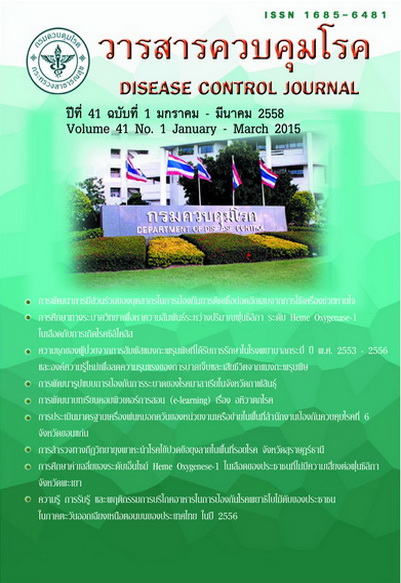Epidemiology study of the association between silica and blood Heme Oxygenase-1 levels with silicosis
DOI:
https://doi.org/10.14456/dcj.2015.27Keywords:
silicosis, silica, Heme Oxygenase-1Abstract
The aim of retrospective cohort analytic study was to determine the correlation between silica dust level, blood Heme Oxygenase-1 (HO-1) and silicosis disease. The interview, air sampling for detection silica dust level, blood HO-1 analysis and chest x-ray were performed on mortar and non-mortar worker at Bansang, Phayao Province. The number of volunteer was 236 cases divided to silica exposure group (mortar worker) 117 cases and non-silica exposure group (non-mortar worker) 119 cases. The data were analyzed using descriptive statistic, percentage, average and binary logistic regression analysis. The results demon¬strated the average of silica dust level in atmospheric workspace of mortar worker was 12.11 mg/cm3 and the maximum was 20.41 mg/cm3. The average of HO-1 on mortal and non-mortar worker were 110.43 and 90.30 ng/ml, respectively. Moreover, this study revealed the silica dust level on atmospheric workspace had the statistic significantly with silicosis disease (p<0.005) by the elevation of silica level lmg/cm3 affected to risk of silicosis 1.218-fold on exposure case comparing with worker who exposed less than 1 mg/cm3. Also, the blood HO-1 level was statistic significantly with silicosis disease (p<0.005). The worker who had the decreasing of blood HO-1 1 ng/ml risked to silicosis 0.977-fold. As well as, this study discovered the statistic significantly correlation between silicosis and duration of work (p<0.005) that the increasing of work time every one year risked to silicosis 1.065-fold. From our studies, the HO-1 level, duration of wok and amount of silica dust related with the progression of silicosis, however, this study was performed on short time so the long time study including evaluated the specificity and sensitivity of test for improvement the screening of early silicosis will be researched.
Downloads
References
2. Kampa M, Castanas E. Human health effects of air pollution. Environ Pollut 2008;151:362-7.
3. Valavanidis A, Fiotakis K, Vlachogianni T. Air¬borne particulate matter and human health: toxi¬cological assessment and importance of size and composition of particles for oxidative damage and carcinogenic mechanism. J Environ Sci Heal c 2008;26:339-62.
4. Sato T, Takieno M, Honma K, Yamauchi H, Saito Y, Sasaki T, et al. Heme Oxygenase-1, a potential biomarker of chronic Silicosis, attenu¬ates silica-induced lung injury. American Jour¬nal of Respiratory and Critical Care Medicine 2006;174:906-14.
5. อภิสิทธิ์ มลาสานต์, กาญจนา คงศักดิ์ตระกูล. โรคซิลิโคสิส (silicosis) [อินเทอร์เน็ต]. [สืบค้นเมื่อ 1 ก.ย. 2552]. แหล่งข้อมูล: http://dpc2.ddc.moph.go.th/option/PSO/ pso2 /data/pic/ 31 .doc
6. สำนักโรคจากการประกอบอาชีพและสิ่งแวดล้อม. สถานการณ์โรคจากการประกอบอาชีพและสิ่งแวดล้อม ปี 2550 [อินเทอร์เน็ต]. [สืบค้นเมื่อ 25 ส.ค. 2552]. แหล่งข้อมูล: http://www.envocc.org/ downloads /env_dis_5 OR 3 .doc
7. Fubini B, Hubbard A. Reactive oxygen species (ROS) and reactive nitrogen species (RNS) gen¬eration by silica in inflammation and fibrosis. Free Radical Biology and Medicine 2003;34: 1507-16.
8. Eom HJ, Choi J. Oxidative stress of silica nanoparticles in human bronchial epithelial cell, Beas-2B. Toxicol In Vitro 2009;23:1326-32.
Downloads
Published
How to Cite
Issue
Section
License
Articles published in the Disease Control Journal are considered as academic work, research or analysis of the personal opinion of the authors, not the opinion of the Thailand Department of Disease Control or editorial team. The authors must be responsible for their articles.






